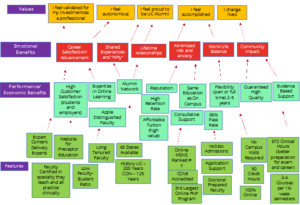By: Tony Winslow, Marketing Manager at Cengage
I was recently talking to a friend at work about how marketing has evolved, the importance of authenticity and how marketers unite around a purpose to create positive change. We talked about the onset of COVID-19 and the months that followed—how marketers knew there was one major thing weighing on everyone’s mind. It required a flip of the switch: stop considering our own agenda and think about what’s going on for our customers first.
His non-marketing background response: “Wait, so it took a pandemic to realize we are marketing to humans?”
It’s not an entirely false conclusion. Customer-centricity has been a focus for marketers for many years, but COVID-19 has been a chance to level set and truly evaluate how we are marketing for people and not at them.
When mapping the customer journey (Awareness, Interest, Desire, Action, Retention), I believe the two most important questions to ask throughout are:
- How are you showing empathy?
- How are you creating delight?
Empathy: Seeing Your Audience as People First
There was an episode of Parenthood titled, “I hear you, I see you.” Zeke used this quote to show his wife, Millie, that he understood her needs and perspectives and stopped focusing on what he wanted first. Since my wife and I watched that episode together several years ago, we’ve used that line to ease tension and let each other know we understand how the other feels (it also makes us laugh).
This is empathy—when you realize that your audience is made up of individuals with cares, desires and dreams. You consider their emotional journey and not just how they fit into the customer journey.
MKTG authors define empathy as “caring, individualized attention to customers.” Empathetic marketers understand their customers by asking questions, sharing their voices and reducing uncertainty and anxiety.
Examples of Empathy from the Field
Chamberlain University’s Happy Nurses Month is a classic “I hear you, I see you” moment. Empathetic marketers effectively, not manipulatively, leverage emotion to help their audience feel understood and appreciated. I view this commercial’s primary journey stage as retention.
Target Audience: current students and alumni
Desired Reaction: “I feel appreciated, loved and important,” and then they share it with others.
Best-selling author and professor, Jonah Berger, states, “When we care, we share.” Therefore, the commercial reaches their audience members in other stages of the customer journey.
Other examples of Empathy
- LUX Resorts CEO trained scripted employees on how to anticipate and understand guest needs so they could be more empathetic and provide individual customer attention. Read more in Chapter 12 of Marketing 2020.
- Zappos reduces up-front costs (therefore anxiety) through free shipping (p. 151, The Catalyst)
- Target makes sure all guests feel welcome, including this little boy in a wheelchair. Before you watch, grab the tissues.
- Peloton uses its community and customer testimonials to foster trust in the brand and alleviate anxiety.
Delight: Helping Customers Climb the Loyalty Ladder
This is the fun part where you get to think more about how to make your customers happy. Happy customers will keep buying from you, and they will tell other people about you.
There are several ways to figure out what makes your customers happy. To name a few: Ask your customers, ask your sales team and do a feature–benefit ladder.
If you think about why people buy things, whether using Maslow’s Hierarchy of Needs or the Means-End Chain Model, every motivation ladders up to happiness. When you do a feature–benefit ladder, you have to ask several questions. I’ll use the example of a drill bit I learned from Professor Drew Boyd.
- What is the product?
- Drill bit.
- What are its features?
- ¼ inch, sharp edges, etc.
- What performance benefits does it provide?
- It creates holes so I can hang pictures.
- What emotional benefits does it provide?
- Smiles, tears, thoughts of lifetime relationships.
5. How does it resonate with customer values?
-
- I feel loved and that I have belonging. I feel happy.
Below is another example of a feature–benefit ladder I made as an academic exercise for a College of Nursing program.

Now that you know what makes customers happy, you think next about how to deliver that joy. Providing hidden surprises, making them feel like insiders and providing great service are three ways to do that. As you read through the examples below, consider assigning your students one company to create a feature–benefit ladder for. In the promotional stage of the marketing plan, have them incorporate similar techniques to the below.
Hidden Surprises: This is when your customers say, “I didn’t know I could do that!” or when they tell their friends, “Look at this!”
-
- Slack is my favorite example of hidden surprises because I constantly find new features on the platform that excite me. I’m a Slack advocate because of the joy they provide when I learn different things and figure out what I can do with it. For example, the ability to create Michael Scott emojis and share them with teammates when a classic smiley face won’t do the trick.
- Millions of households have Netflix, but don’t you feel a sense of pride when you share a hidden Netflix gem?
- It doesn’t have to be software – I walked into Dewey’s Pizza a few weeks ago, and I was pumped when they had my favorite seasonal pizza.
- Costco has exclusive membership deals, and they rotate their product offerings and deals so you never know what you may find when you enter a store.
- Coca-Cola, in 2017, put a name on every bottle. For example, “Share a Coke with Jordan.” It gave customers a word-of-mouth trigger and delighted them, not because of the product, but because of the feeling they got when they shared the picture with their friends.
Make them feel like insiders: This is how you help your customers feel attached to your brand.
-
-
- As an avid fan of The Office, I was delighted when Peacock sent me this email. I felt like I was part of an exclusive club, and that Peacock understood the loyalty I have to the show.
- Years ago, I entered a competition to submit a song or video detailing my burrito concoction at Chipotle. I can still rehearse all the lyrics, e.g. “That’s the Tito burrito, put me on the menu please.”
- Taco Bell ran a “sponsored lens” campaign on Snapchat in 2016 resulting in 224 million views in a single day. Read more in chapter 5 of Contemporary Marketing, 19e.
-
Provide great service: This is how you get customers to go out of their way to talk about you.
-
- Some companies, like Home Depot, provide their associates a level of autonomy to make things right when customers have a poor experience. They don’t involve managers or require long customer defenses.
- Netflix doesn’t hide the cancel button, making it easy to cancel or pause unwanted subscriptions. This is also an example of empathy. I once spent over an hour trying to cancel a $4 monthly subscription on the phone. I’ll never subscribe to this business again.
- A detailed and well-organized FAQ will go a long way in saving your customers time.
Back to Purpose
Ryan Berg, founder of the Aruna Project, stated “When done right, purpose is not a product. It doesn’t exist to be sold. It exists to guide, push, empower, impassion.”
Purpose is the first step in marketing for your customers and not at them. It’s the foundation of creating a marketing plan, and empathy and delight tactics allow marketers to inject purpose into every stage of the customer journey.

